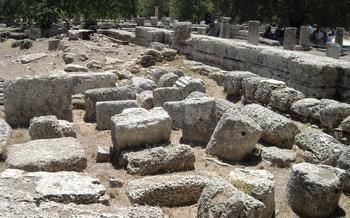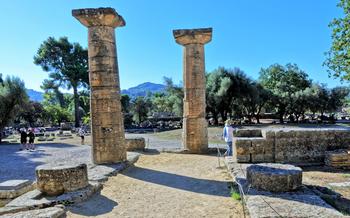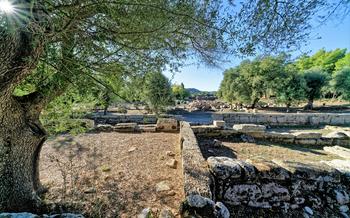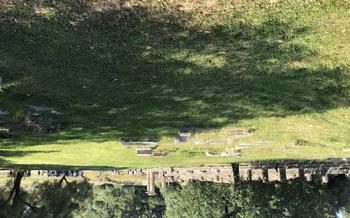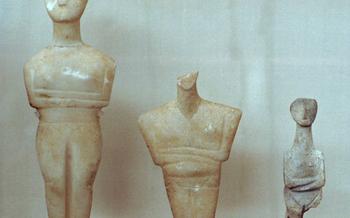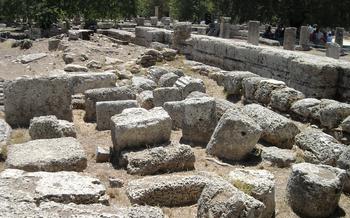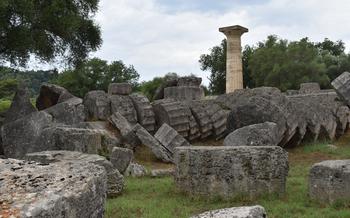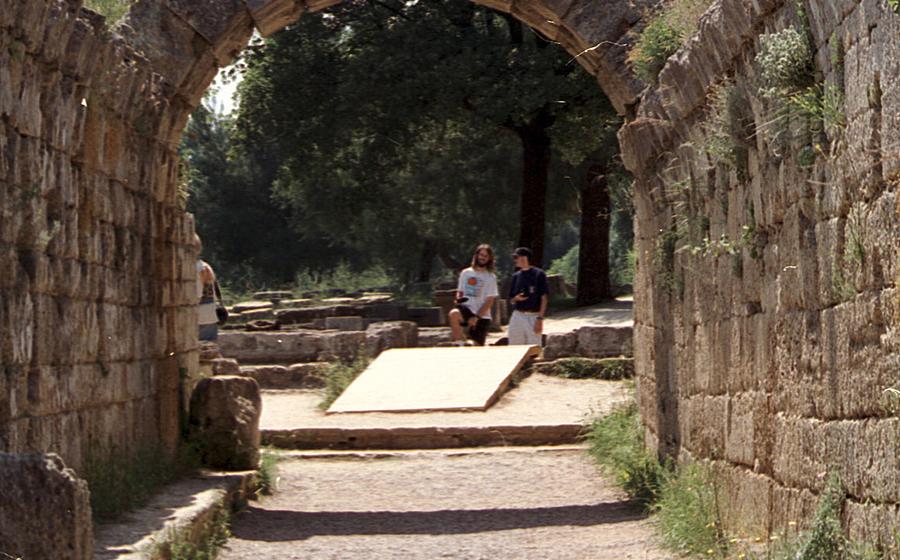
Crypt (arched entrance to the stadium)
- Olympia: A Journey Through Time
- Exploring the Crypt: Gateway to Ancient Sporting Events
- Unveiling the Secrets of the Arched Entrance
- Witnessing the Olympic Games from the Crypt
- Exploring the Stadium: Where Legends Were Made
- The Olympic Flame: A Symbol of Unity and Sportsmanship
- The Museum of Olympia: A Treasure Trove of Ancient Artifacts
- The Peloponnese Region: A Land of History and Beauty
- Ancient Olympia vs. Modern Olympics: Similarities and Differences
- Planning Your Visit to Olympia: Practical Tips
- Unforgettable Experiences in Olympia: Beyond the Crypt
- Events and Festivals in Olympia: Celebrating the Past and Present
- Capturing the Essence of Olympia: Photography Tips
- Preservation and Conservation Efforts in Olympia
- Insider Tip: Exploring the Crypt at Dawn
Olympia: A Journey Through Time
Olympia, nestled in the picturesque valley of Elis in the Peloponnese region of Greece, is a place where history, mythology, and sportsmanship intertwine. As the birthplace of the ancient Olympic Games, Olympia holds immense significance for history and sports enthusiasts worldwide. The archaeological site of Olympia, a UNESCO World Heritage Site, offers a fascinating glimpse into the origins of the Olympic tradition and the grandeur of ancient Greece.
My first visit to Olympia was an awe-inspiring experience. As I stepped onto the sacred grounds, I couldn't help but feel a sense of reverence for the place that gave birth to the Olympic spirit. The ancient ruins, bathed in the warm Greek sunlight, seemed to whisper stories of athletic prowess, fierce competition, and the pursuit of excellence. It was an unforgettable journey through time, where the echoes of the past resonated in every stone and every breath of wind.
Exploring the Crypt: Gateway to Ancient Sporting Events
The Crypt, also known as the Entrance to the Stadium, is a captivating structure located at the ancient Olympic Games site in Olympia, Greece. Situated at the western end of the stadium, it served as the grand entrance for athletes and officials during the ancient Olympic Games. The Crypt's architectural features are awe-inspiring, showcasing the remarkable engineering skills of the ancient Greeks. Its arched passageway, constructed from massive stone blocks, leads visitors into the heart of the ancient sporting arena.
Beyond its physical presence, the Crypt holds immense historical significance. It was through this gateway that the Olympic athletes, adorned in their finest attire, would process into the stadium, their hearts pounding with anticipation and excitement. The Crypt witnessed the triumphs and defeats of countless athletes, the roar of the crowd, and the crowning of Olympic champions. It played a pivotal role in the ancient Olympic rituals, as athletes and officials would gather here to make offerings and seek divine favor before the competitions.
Imagine the scene: the sun casting its golden rays upon the Crypt's imposing facade, as a procession of athletes, adorned in vibrant colors, emerges from the arched entrance. The air is filled with a mix of anticipation, excitement, and the rhythmic sound of their footsteps. The crowd erupts in cheers, their voices echoing through the ancient stadium, as the athletes march towards their destiny, ready to compete for glory and honor.
Unveiling the Secrets of the Arched Entrance
The Crypt's architectural elements showcase the artistry and craftsmanship of ancient Greek builders. Its facade boasts intricate carvings and bas-reliefs depicting scenes from Greek mythology and sporting events. These carvings provide a glimpse into the beliefs and values of the ancient Greeks, showcasing their reverence for the gods and their passion for athletics.
One of the most striking features of the Crypt is its arched entrance, which is flanked by two massive columns.
Witnessing the Olympic Games from the Crypt
Standing within the Crypt, one can almost hear the roar of the crowd and feel the excitement of the ancient Olympic Games. The Crypt served as a gateway for the athletes, who would process through its arched entrance and onto the stadium grounds. Before the competitions began, rituals and ceremonies were performed at the Crypt to honor the gods and pay homage to the Olympic ideals.
Imagining myself as one of those ancient athletes, I felt a surge of adrenaline and awe. The Crypt would have been the last stop before stepping into the arena, where thousands of spectators awaited. The atmosphere must have been electric, with the cheers and chants of the crowd reverberating through the air.
The Crypt was more than just an entrance; it was a symbol of the unity and sportsmanship that defined the ancient Olympic Games. Athletes from different city-states came together in Olympia, setting aside their rivalries and competing in the spirit of friendly competition. This sense of camaraderie and mutual respect was embodied by the Crypt, which stood as a testament to the power of sports to bring people together.
Exploring the Stadium: Where Legends Were Made
Just a stone's throw from the Crypt lies the ancient stadium of Olympia, the birthplace of the Olympic Games. Constructed in the 5th century BC, this awe-inspiring arena once hosted the most prestigious sporting events in the ancient world. With a seating capacity of over 45,000 spectators, the stadium was a marvel of engineering and a testament to the Greeks' passion for athletics.
The stadium's layout is simple yet effective. A long, narrow track, approximately 192 meters in length, is flanked by earthen embankments that served as seating for the spectators. The starting and finishing lines are marked by parallel stone blocks, and at one end of the stadium stands a raised platform, the judges' stand, from where the officials presided over the competitions.
The stadium's historical significance cannot be overstated. It was here that the Olympic Games, a symbol of unity and athleticism, were held every four years for over a millennium. The games brought together athletes from all corners of the Greek world, fostering a sense of pan-Hellenic identity and celebrating the human spirit of competition.
Standing in the stadium today, one can almost hear the roar of the crowd, the cheers and jeers as the athletes pushed their limits in pursuit of victory. The stadium's atmosphere is palpable, a testament to the enduring legacy of the ancient Olympic Games. For any sports enthusiast or history buff, a visit to the stadium is a pilgrimage to the birthplace of athletic excellence.
In a moment of inspiration, I decided to run a lap around the ancient track. The uneven ground and the sheer length of the course made it a challenging endeavor, but as I crossed the finish line, I felt a profound connection to the athletes of old. Running in the same stadium where legends were made was an experience that left me breathless and filled with awe.
The Olympic Flame: A Symbol of Unity and Sportsmanship
The Olympic flame, a symbol of unity, peace, and sportsmanship, holds a special significance in Olympia, the birthplace of the ancient Olympic Games. The flame, representing the continuity of the Olympic spirit, is lit in a traditional ceremony at the Temple of Hera in Olympia, using the sun's rays focused by a parabolic mirror. This sacred flame is then carried by torchbearers in a relay race to the host city of the Olympic Games, symbolizing the journey of the Olympic spirit across the world.
The Crypt, as the gateway to the ancient stadium, played a crucial role in the modern Olympic torch relay ceremony. In 1936, during the Berlin Olympic Games, the torch relay was introduced as a way to connect the ancient and modern Olympic traditions. The flame, lit in Olympia, was carried through the Crypt, marking the start of its journey to the Olympic stadium in Berlin. This tradition has continued in every subsequent Olympic Games, with the flame passing through the Crypt, symbolizing the continuity of the Olympic spirit from its ancient roots to the present day.
Witnessing the lighting of the Olympic flame in Olympia is a truly awe-inspiring experience. The ceremony, steeped in tradition and symbolism, evokes a sense of unity and global camaraderie. As the sun's rays converge to ignite the flame, the atmosphere crackles with excitement and anticipation. The flame, carried by torchbearers, embarks on its journey, spreading the message of peace and sportsmanship worldwide.
The Museum of Olympia: A Treasure Trove of Ancient Artifacts
Located a short walk from the ancient stadium, the Museum of Olympia is a treasure trove of artifacts that offer a glimpse into the world of the ancient Olympic Games. Established in the late 19th century, the museum houses a vast collection of sculptures, pottery, bronzes, and other objects excavated from the archaeological site.
Among the highlights of the museum's collection are the exquisite sculptures from the Temple of Zeus, including the iconic statue of Hermes carrying the infant Dionysus. The museum also displays a collection of bronze statues of athletes, including the famous "Discobolus" (Discus Thrower) and the "Wrestlers."
In addition to sculptures, the museum exhibits a wealth of pottery, including painted vases, amphorae, and drinking cups. These vessels often depict scenes from mythology, daily life, and, of course, the Olympic Games.
A visit to the Museum of Olympia is a must for anyone interested in ancient history, sports, or art. The museum's collection provides a fascinating glimpse into the world of the ancient Greeks and the origins of the Olympic Games.
Personal Experience: Discovering Hidden Gems in the Museum's Collection
During my visit to the Museum of Olympia, I was particularly drawn to a small, unassuming bronze statuette of a running athlete. The statue, which was only a few inches tall, captured the essence of athleticism and determination. I spent several minutes admiring the intricate details of the sculpture, from the athlete's flowing hair to the muscles straining in his legs.
As I continued to explore the museum, I discovered other hidden gems, including a delicate gold ring engraved with the Olympic emblem and a collection of ancient oil lamps that were once used to illuminate the stadium during night events. Each artifact told a story about the ancient Olympic Games and the people who participated in them.
The Peloponnese Region: A Land of History and Beauty
The Peloponnese, a peninsula in southern Greece, is a treasure trove of ancient history, natural wonders, and cultural delights. Steeped in mythology and legends, the region boasts a rich tapestry of civilizations, from the ancient Greeks and Romans to the Byzantines and Venetians.
Nestled between the Ionian and Aegean Seas, the Peloponnese is a land of contrasts, with rugged mountains, fertile valleys, pristine beaches, and picturesque villages. Explore ancient ruins, such as the Temple of Apollo at Corinth and the Mycenaean Palace of Nestor in Pylos, that stand as testaments to the region's glorious past.
Discover the natural beauty of the Peloponnese in its stunning landscapes. Hike through the lush forests of Mount Taygetus, marvel at the cascading waterfalls of Polilimnio, or relax on the golden sands of Elafonisos beach.
The Peloponnese is also renowned for its vibrant culture and traditions. Indulge in the region's delectable cuisine, featuring fresh seafood, locally produced olive oil, and delicious cheeses. Experience the warmth and hospitality of the Peloponnesian people as you explore traditional villages and towns.
From the bustling streets of Kalamata to the serene landscapes of Monemvasia, the Peloponnese offers an unforgettable journey through history, nature, and culture. Explore hidden gems, discover ancient secrets, and create lasting memories in this captivating region.
Anecdote: Exploring Hidden Villages and Off-the-Beaten-Path Gems in the Peloponnese
During my travels in the Peloponnese, I stumbled upon the charming village of Dimitsana, nestled amidst the scenic Mainalo Mountains. With its traditional stone houses, cobblestone streets, and breathtaking views of the surrounding valleys, Dimitsana exuded an old-world charm that transported me back in time.
I wandered through the village, admiring the well-preserved Byzantine churches and the picturesque squares adorned with colorful flowers. I stopped at a local taverna to savor the flavors of Peloponnesian cuisine, indulging in a delicious feast of grilled meats, fresh salads, and homemade wine.
As I explored further, I discovered a hidden gem – a secluded waterfall nestled in the lush forest just outside the village. The sound of the cascading water and the fresh mountain air created a tranquil oasis, perfect for escaping the summer heat.
My journey through the Peloponnese was filled with such unexpected discoveries, as I ventured off the beaten path to uncover the region's hidden treasures. Each village, each landscape, and each encounter revealed a new facet of this captivating land.
Ancient Olympia vs. Modern Olympics: Similarities and Differences
The similarities between the ancient and modern Olympic Games can be traced to the core values and principles that underpin both events. Both iterations celebrate sporting excellence, promote international unity, and foster a sense of camaraderie among athletes from different nations. The spirit of competition and the pursuit of athletic glory remain at the heart of both events, creating a sense of excitement and anticipation among athletes and spectators alike.
However, there are also notable differences between the ancient and modern Olympic Games. The ancient games were primarily religious festivals dedicated to the Greek gods, particularly Zeus, the king of the gods. Athletic competitions were held as part of these religious observances, and victories were seen as a sign of divine favor. In contrast, the modern Olympic Games are secular events that focus on promoting sportsmanship, fair play, and international cooperation.
Another key difference lies in the scale and scope of the games. The ancient Olympic Games were relatively small-scale events, with a limited number of athletes and sports. The modern Olympic Games, on the other hand, have grown into a global sporting spectacle, attracting thousands of athletes from over 200 countries and featuring a wide range of sports.
The evolution of the Olympic Games over time reflects the changing values and priorities of society. The ancient games were deeply rooted in religious beliefs and local traditions, while the modern games have evolved into a global celebration of sports and international unity. Despite these differences, the Olympic Games continue to embody the ideals of athleticism, fair play, and the pursuit of excellence, carrying forward a legacy that began in ancient Olympia over 2,500 years ago.
Planning Your Visit to Olympia: Practical Tips
To make the most of your visit to Olympia, careful planning is essential. The best time to visit is during the shoulder seasons (spring and autumn) when the weather is pleasant, and the crowds are smaller. Olympia is accessible by car, bus, or train from major cities like Athens and Patras. Once there, you'll find a range of accommodation options near the archaeological site, catering to different budgets.
When exploring Olympia, comfortable shoes are a must, as you'll be doing a lot of walking on uneven surfaces. Don't forget to bring water, sunscreen, and a hat to protect yourself from the sun. A camera is a must-have to capture the stunning sights, and a guidebook or audio tour can provide valuable insights into the history and significance of the site.
To avoid the crowds and enjoy a more intimate experience, consider visiting the Crypt early in the morning or late in the afternoon. Guided tours are available if you prefer to learn more about the site from an expert guide. Remember to be respectful of the ancient ruins and follow the designated paths to avoid damaging the fragile remains.
Unforgettable Experiences in Olympia: Beyond the Crypt
While the Crypt is undoubtedly a highlight, Olympia offers a myriad of other captivating experiences that transport visitors back in time. Immerse yourself in the arts at the Ancient Olympia Theater, where performances of classic Greek plays and concerts bring the past to life. Explore the awe-inspiring Temple of Zeus, a testament to the architectural prowess of ancient Greece, and pay homage to the king of the gods. Escape the bustle of the archaeological site and embark on a hiking adventure in the picturesque countryside surrounding Olympia. Marvel at the stunning views as you traverse lush forests, encounter ancient ruins nestled amidst the landscape, and discover hidden gems off the beaten path. As the sun dips below the horizon, find a tranquil spot along the Alpheus River and witness a magical sunset, casting a golden glow upon the ancient ruins and creating an unforgettable memory.
Events and Festivals in Olympia: Celebrating the Past and Present
Olympia, with its rich history and cultural significance, hosts a variety of events and festivals that celebrate the past and present. The most prominent of these is the Olympia International Festival, held annually in July and August. This vibrant festival showcases a diverse range of cultural expressions, including traditional Greek music, dance, theater, and art exhibitions. It's a fantastic opportunity to immerse yourself in the local culture and experience the vibrant energy of Olympia.
Another highlight is the Olympic Flame Lighting Ceremony, which takes place every two years to mark the start of the Olympic Games. This solemn and symbolic event draws visitors from around the world who come to witness the lighting of the Olympic flame at the Temple of Hera. The flame is then carried by torchbearers on a global relay, eventually reaching the host city of the Olympic Games.
I had the privilege of attending a traditional Greek festival in Olympia, where I experienced the warmth and hospitality of the local community. The festival featured lively music, traditional dances, and delicious local cuisine. It was a wonderful opportunity to connect with the people of Olympia and learn more about their customs and traditions.
Capturing the Essence of Olympia: Photography Tips
The Crypt, with its iconic arched entrance, is a photographer's dream. To capture its grandeur, use a wide-angle lens to fit the entire structure into the frame. Experiment with different angles, shooting from below to emphasize its height or from a distance to showcase its surroundings. Use a tripod for stability, especially in low-light conditions.
For the best lighting, visit the Crypt during the golden hours, just after sunrise or before sunset. The warm light will enhance the texture and colors of the stone. To capture the spirit of the ancient site, include people in your shots to convey the scale and human connection to the Crypt.
Don't forget to experiment with different shutter speeds. A slow shutter speed can create a sense of movement, while a fast shutter speed can freeze the action. And don't just focus on the Crypt; capture the surrounding ruins, the lush greenery, and the vibrant sky to create a well-rounded visual story of Olympia.
Preservation and Conservation Efforts in Olympia
Olympia, with its rich historical and cultural significance, faces the challenge of preserving its ancient ruins while accommodating the influx of visitors. Ongoing projects aim to protect and restore the archaeological site, ensuring its legacy for future generations. These efforts include structural reinforcement, restoration of artifacts, and excavation and research to uncover new insights into the past.
Preserving Olympia's heritage requires a delicate balance between conservation and accessibility. Sustainable tourism practices are encouraged, promoting responsible exploration and minimizing environmental impact. Visitors are reminded to respect the fragile remains and follow designated paths to avoid further damage.
Conservation efforts extend beyond the physical ruins to encompass the surrounding natural environment. The Alfeios River, a vital part of Olympia's landscape, is being restored to its former glory, with projects to improve water quality and protect its biodiversity.
As a traveler, you can contribute to the preservation of Olympia by being a responsible visitor. Follow designated paths, avoid touching or climbing on the ruins, and dispose of waste properly. By supporting local initiatives and businesses that promote sustainable practices, you can help ensure that Olympia's treasures remain intact for generations to come.
Insider Tip: Exploring the Crypt at Dawn
While Olympia is a captivating destination at any time of day, there's something truly magical about experiencing the Crypt at dawn. As the first rays of sunlight gently illuminate the ancient ruins, the atmosphere is serene and tranquil, offering a unique and unforgettable experience.
Imagine standing before the Crypt, bathed in the warm glow of the rising sun, with the ancient stadium stretching out before you. The absence of crowds allows you to fully appreciate the grandeur of the site and connect with its history on a deeper level.
This is the ideal time to capture stunning photographs of the Crypt. The soft, golden light casts beautiful shadows and highlights, accentuating the architectural details and creating a sense of depth and dimension. With fewer people around, you'll have the freedom to experiment with different angles and compositions, capturing the Crypt's essence without distractions.
As you stand there, enveloped in the tranquility of the early morning, you can almost feel the presence of the ancient athletes who once stood in the same spot, preparing for their competitions. The Crypt, once a gateway to sporting glory, now stands as a testament to the enduring spirit of the Olympic Games.
Whether you're a history buff, a sports enthusiast, or simply someone who appreciates the beauty of ancient ruins, visiting the Crypt at dawn is an experience that will stay with you long after your trip to Olympia.
